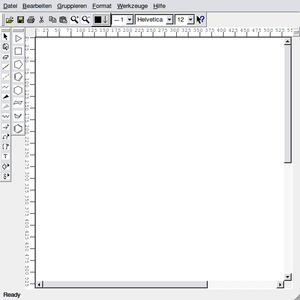XDrawChem
Appearance
 XDrawChem 1.9.9 | |
| Stable release | 1.10.2
/ January 9, 2017 |
|---|---|
| Repository | github |
| Written in | C++ |
| Operating system | UNIX and X Window (Linux, SGI IRIX, Sun Solaris, others...) or macOS |
| Type | Molecular editor |
| License | GNU GPL |
XDrawChem is a free software program for drawing chemical structural formulas, available for Unix and macOS. It is distributed under the GNU GPL. In Microsoft Windows this program is called WinDrawChem.[1]
Major features
[edit]- Fixed length and fixed angle drawing
- Automatic alignment of figures
- Detection of structures, text, and arrows, and their automatic placement
- Can automatically draw rings and other structures - has all standard amino acids and nucleic acids in a built-in library
- Retrieval of structures from a network database based on CAS number, formula, or name
- Retrieval of information on a molecule based on a drawing
- Symbols such as partial charge and radicals
- Reading MDL Molfiles, CML (Chemical Markup Language), ChemDraw binary format, ChemDraw XML text format[2]
- Writing MDL Molfiles, CML, ChemDraw XML text format
- Integration with OpenBabel, allowing XDrawChem to read and write over 20 different chemical file formats.
- Image export in Portable Network Graphics (PNG), Windows bitmap, Encapsulated PostScript (EPS), and Scalable Vector Graphics (SVG)
- 3D structure generation with the help of the external program BUILD3D
- Simple spectra predictions, including 13C-NMR, 1H-NMR (based on additive rules and functional group lookup methods), and IR[3]
- Simple property estimation, including pKa, octanol-water partition coefficient, and gas-phase enthalpy change.
References
[edit]- ^ Gupta, Monika (2023). "Ict Tools for Teaching and Research in Chemistry". International Research Journal of Modernization in Engineering Technology and Science. 5 (1). doi:10.56726/IRJMETS32852.
- ^ Namitha k n; v Velmurugan (30 May 2022). "Review of bioinformatic tools used in Computer Aided Drug Design (CADD)". World Journal of Advanced Research and Reviews. 14 (2): 453–465. doi:10.30574/wjarr.2022.14.2.0394.
- ^ Winkler, David (2017-09-01). "Free software for chemistry". Chemistry in Australia: 24–27.
